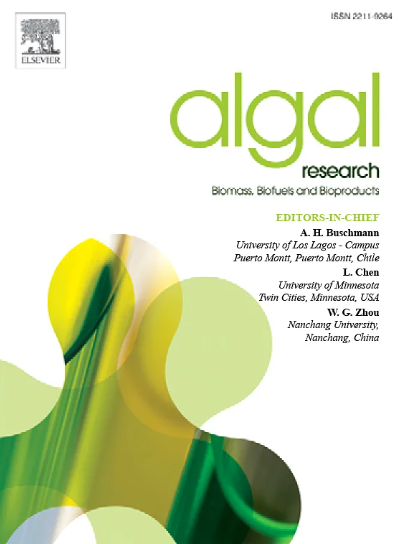Valorisation of tannery wastewater with indigenous microalgal strains: Acclimation, identification, biomass characterization and remediation
IF 4.6
2区 生物学
Q1 BIOTECHNOLOGY & APPLIED MICROBIOLOGY
Algal Research-Biomass Biofuels and Bioproducts
Pub Date : 2025-03-01
DOI:10.1016/j.algal.2025.103953
引用次数: 0
Abstract
Tannery wastewater contains high concentrations of inorganic and organic pollutants and requires extensive remediation before discharge. In this study, four of ten promising microalgal strains were successfully acclimated to 50 % raw tannery effluent. Three of the strains were indigenous species that were identified using molecular techniques and designated as Tetradesmus obliquus CPUT-L1, Tetradesmus dimorphus CPUT-L2 and Neochloris sp. CPUT-W1. The biomass concentrations (1.50 ± 0.017 to 1.11 ± 0.04 g/L) compared well with literature values for growth of microalgae in wastewater. Growth in the nitrogen-rich tannery effluent drove the metabolism of all four strains to produce higher amounts of carbohydrates (12.7–19.8%wt.wt.) and proteins (24.5–37.2%wt.wt.) than fatty acids (7.40–13.3%wt.wt.). Results suggest that the high-protein biomass could be used as an animal feed supplement because all samples also contained a range of micronutrients, and the concentrations of toxic metals were compliant with the World Health Organization standards for human consumption. All strains were able to completely remove ammonia (12 mg/L) from the effluent. The concentrations of soluble COD (489 ± 4 mg/L) did not change significantly after remediation and there were notable increases (64–89 %) in total COD from influent (876 ± 4 mg/L) to effluent due to autotrophic microalgal growth. All the strains formed large coenobia, allowing the biomass to settle readily without the need for physical or chemical interventions. Overall, the results showed that the acclimated microalgal strains have the potential to be used in a tannery biorefinery for simultaneous polishing of tannery effluent and possible utilization of the biomass as animal feed.

求助全文
约1分钟内获得全文
求助全文
来源期刊

Algal Research-Biomass Biofuels and Bioproducts
BIOTECHNOLOGY & APPLIED MICROBIOLOGY-
CiteScore
9.40
自引率
7.80%
发文量
332
期刊介绍:
Algal Research is an international phycology journal covering all areas of emerging technologies in algae biology, biomass production, cultivation, harvesting, extraction, bioproducts, biorefinery, engineering, and econometrics. Algae is defined to include cyanobacteria, microalgae, and protists and symbionts of interest in biotechnology. The journal publishes original research and reviews for the following scope: algal biology, including but not exclusive to: phylogeny, biodiversity, molecular traits, metabolic regulation, and genetic engineering, algal cultivation, e.g. phototrophic systems, heterotrophic systems, and mixotrophic systems, algal harvesting and extraction systems, biotechnology to convert algal biomass and components into biofuels and bioproducts, e.g., nutraceuticals, pharmaceuticals, animal feed, plastics, etc. algal products and their economic assessment
 求助内容:
求助内容: 应助结果提醒方式:
应助结果提醒方式:


